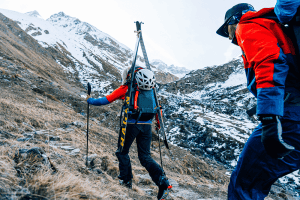Late risers have a hard time
"Leave early, return early" is the motto in spring. This ironclad basic rule brings safety. Because those who start too late live dangerously. On concave firn slopes and glaciers, temperatures can sometimes reach 20 degrees or more in the late morning. In a few hours, the snow changes from hard to light and then to heavy firn and finally to black ice. The basic rule is that by midday you should be back in the valley or at the hut. And it is not only about safety. The firn does not wait. Who wants to start the descent in wet and lazy "Hax'nbrecher" snow?
Plan ahead
There are many tools available for tour planning. In a number of forums on the Internet, tourers report on their undertakings. You can also use webcams to get an impression of the situation on site. But be careful: you should always compare the personal and therefore subjective information from the web with the avalanche reports.
These include:
- www.alpenverein-austria.at
- www.lawinenwarndienst-bayern.de
- https://lawinen.report
- www.avalanches.org
- www.lawis.at.
For digital planning there are, for example, with www.alpenvereinaktiv.com and www.whiterisk.ch clever tools that help you to plan taking into account the avalanche and weather situation, create tracks and download them to the GPS or smartphone. But you also need to take a look at the "analog" map. Here you can identify potential danger spots, for example steep areas above 30 degrees or the danger spots indicated in the situation report in relation to the compass direction.
Harsch and crampons
The ascent track is often in an unpleasant condition in the morning. Overnight it has frozen like icing on a chocolate cake. As hard as concrete and sometimes as bumpy as a field. The skins quickly reach their limits on steep sections. You are constantly slipping backwards. That costs energy. That's why crampons should be in your rucksack on every tour. The same applies to crampons. Steep cirques or gullies can mutate into tough "Wadelbeissers" that are impossible to tackle without twelve-toed crampons. A short ice axe may even make sense. However, you should be clear about whether you can master these last few meters on the descent. In most cases, it makes sense to leave your skis behind beforehand or to finish the ascent at the depot.
Fur wax
A moment ago you were out in the sun, now the ascent is in the shade. And then it happens: Thick clumps stick to the skins and make walking really difficult. Even if skins are less prone to clogging these days due to their good quality, sometimes it does happen. Then it's time to fight. If you don't want to spend minutes laboriously scraping the studs off with a pole, treat the skins with a special skin wax or spray beforehand. Our tip: A coat wax is part of the basic equipment in spring.
Drink a lot
Even a fluid loss of about 1 percent of body weight causes a noticeable drop in performance and is reached faster than you think. For a man weighing 80 kilograms, that's 800 ml of water. That is quickly sweated out. Therefore, you should take plenty to drink with you. The basic rule is: rather more often and less than rarely and much. You should drink about 500 -750ml of liquid per hour. Best in regular intervals. A water bag with a hose makes sense, because it allows you to drink regularly without having to take off your backpack.
Proper clothing
The higher position of the sun in spring makes the UV radiation reflect more strongly through the snow than in winter. Therefore, a good sunscreen with a high sun protection factor and lip protection are standard equipment. Glacier goggles with dark category three or four lenses are also a must when the sky is overcast. And even if it gets warm during the day: Hard or soft shell, including several layers of clothing, hat, gloves and a change of underwear naturally belong in your luggage.
Save the feet
On some tours, you have to walk a good distance before you come into contact with the snow for the first time. In touring boots, this can be quite a challenge for your feet. If you're smart, you can walk this distance in sneakers, which you then put under a stone or hide in the bushes at the actual start of the tour. A bicycle can also make sense for particularly long approaches or is indispensable for some tours.
Our conclusion
In summary, you should definitely pay attention to the following points:
- Is my material correct (enough glue on the skins, avalanche transceiver functional, maps, GPS available).
- Always follow the LLB (avalanche situation report)
- Never travel alone
- Timing of the tour: are sufficient buffers included
- Fresh snow: the day after is the most dangerous
- Wind is the master builder of avalanches
- In spring, the conditions relax more quickly due to the increased sunlight
- Cold conserves the snow situation
- Slope: as soon as you have to make hairpin turns to turn, the slope is steep enough for avalanches to occur
Spring ski tours are an absolute highlight for us at HAGAN. Pleasantly warm summit rest, effortless swings in the firn and apple spritzer or cyclist on the hut terrace in the sun: heart, what more do you want.
